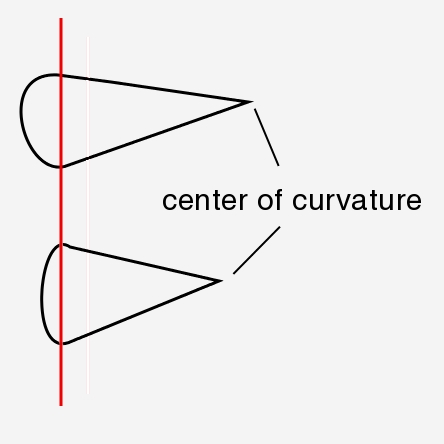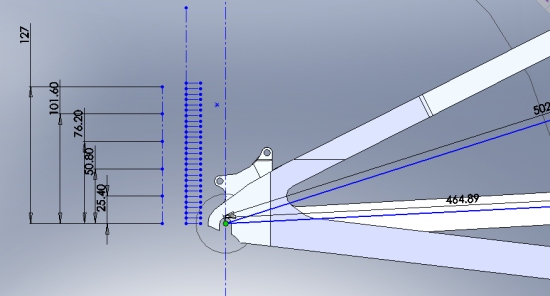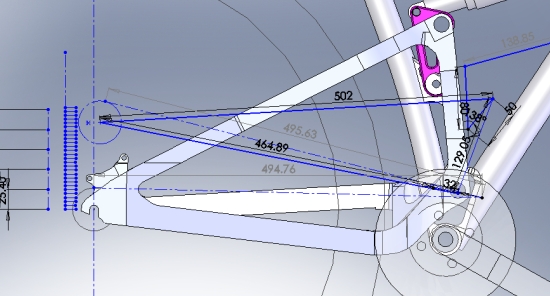I haven’t been producing all that much hairy pseudo-engineering frame project dilemma blues lately, have I? Mostly psycho-socio-politico rants. As it turns out, I’m still trying to make a bicycle frame, and it’s still a lot like having a super violent bar fight all by yourself. Geeks, this one’s for you.
Ah, life’s timeless questions. Like how much chain growth is acceptable at full travel?
Designed for 29er wheel tire clearance and short chainstays at full travel, my original design was a near vertical axle path. I mean really near vertical. We’re talking a few millimeters. Vertical.
That all adds up to one thing: crazy short chainstays, a characteristic I’m pursuing in a big way on this design, but the trade-off is potential “pedal kickback.”
Depending on which suspension guru you’re talking to, and which side of the bed he or she got out of that morning, pedal kickback is either a nominal concern or the holy-freakin-grail. What is it? Well, there’s this line of torque that drives your bicycle. When you do your mad flailing attempts at pedaling a bike, the energy of your legs rotates the crankset and thus chainring, and at that point, power runs across the top of your chain like a group of magic little elves. It’s that top of the chain–the path that runs from the top of your chainring to the top of your cassette–that’s under tension and is propelling your bike along for you.
Well, when you add a rear wheel that can go up and down relative to the bottom bracket on your bike, you’ve done some strange things to the length of that line. What exactly you did to it depends on where your bike’s pivot center point is (most of those center points or centers of curvature are “virtual” or move around, though it’s easy to find the center point of a single-pivot bike: it’s just the pivot location). That center of curvature point created by the location of the pivots on a suspension frame determines the shape of your axle path.

Red line represents pure vertical, but the arcs of actual axle paths are determined by the center of curvature.
So as your rear wheel goes up and down, the magical “power line” connecting your chainring gear and the gear driving your rear wheel tracks along with the arc of your axle path–the one that’s being created by that center of curvature.
All this just means your chain gets long and shorter as the suspension moves through its travel. How much deviation in chain length you have affects whether or not your bike’s suspension system tugs backward on your chain (which sucks if not moderated effectively) or slackens your chain (which also is no fun). Usually, the point at which your suspension is the most compressed is the problem, as that’s the point at which the distance from your chain’s engagement on your chainring to its engagement point on a given rear cog is the greatests. That hurt my head even to type, so here’s an image. Check out the gray numbers. Those represent the length of the chain when the bike isn’t compressed (494.76mm) and when it’s compressed all the way (495.63mm).
In order to get those numbers so close to one another, I had to redesign my frame, and what I traded was approximately 8mm of chainstay length.
So here’s my question to hardcore bike nerds out there: Which is more important, minimizing that chain growth at the end of the bike’s travel, or having really short chainstays?
I’m really only concerned with end of the axle path (full compression). If you have a vertical axle path, your chain grows a good bit (like up to 10mm), but if you arc your axle path inward slightly at the end, you can all but eliminate any chain growth. During the rest of the axle’s path, I’m still going to have very little rearward axle movement. It’ll be there, but it’ll be minimal. So the big question is how far forward to eliminate chain growth do I let the axle roam at the end of the bike’s travel? The further it moves in to maintain consistent chain length, the less clearance between the rear wheel and the frame’s seat tube.
Anyway, that’s what I’m working on right now, instead of sleeping.



Sorry, the comment form is closed at this time.